Speech Developments in Secured Issuance and RBA Reporting Initiatives
Thank you for giving me the opportunity to speak at this forum. Today I would like to do two things. Firstly, I will take the opportunity to reflect on developments in secured issuance in recent years. And secondly, I will speak a little about the Reserve Bank's reporting initiatives in this area.
Two Years of Covered Bonds
It is almost two years to the day since the first covered bond was issued by an Australian bank. It was not an easy time for new issuers. Financial markets were volatile, and the US Federal Reserve, the European Central Bank and the Bank of England had all announced non-conventional policies towards the end of 2011. The covered bonds that were issued – AAA rated 5-year securities – were sold at spreads to Commonwealth Government Securities of more than 220 basis points.
Ultimately, conditions improved. Over the two years since the passage of enabling legislation, covered bonds have proven to be a useful source of funding for Australian banks, notwithstanding the fact that they have brought about some subordination of unsecured debtholders. About A$57 billion has been raised, predominantly in offshore markets (Graph 1). This represents just over one-quarter of the banks' long-term debt issuance over this period, although the pattern of issuance has evolved with financial market conditions.[1] In particular, covered bonds have proven useful as a wholesale funding source that is less sensitive to global risk events than traditional unsecured funding. This was evident in the banks' issuance of predominantly covered bonds in early 2012 as conditions in funding markets deteriorated because of sovereign debt concerns, particularly in Europe.
Around that time, the Reserve Bank noted that the delineation between secured and unsecured funding for the banking system was perhaps not as stark as market conditions implied.[2] As it turned out, conditions in global unsecured funding markets improved from mid 2012, and Australian banks returned to what might be considered more typical patterns of issuance – raising the majority of their wholesale funding via unsecured bonds.
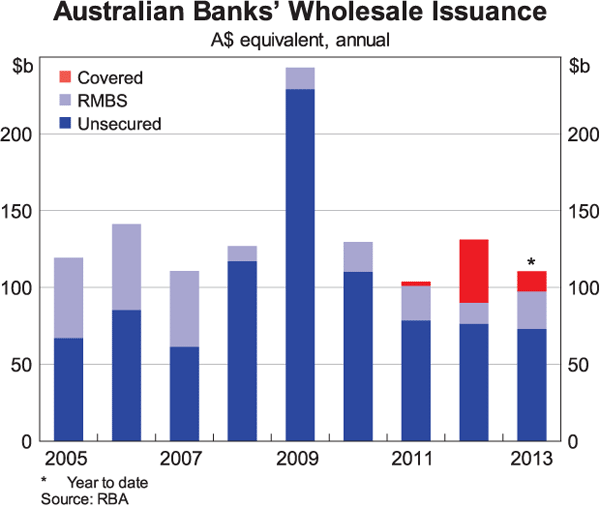
Importantly, covered bonds have enabled banks to diversify their investor base and reduce their funding risk. Australian banks' covered bonds have consistently been rated AAA, which has allowed the banks to attract new funding from investors with AAA mandates. This may also have assisted those banks repurchasing their government-guaranteed debt, as the banks were able to offer investors an alternative AAA asset to invest in.
There is also some evidence of a broadening in banks' investor base along the geographical dimension, with regional central banks among the buyers of Australian banks' covered bonds. European investors have also provided demand for these instruments, reflecting their familiarity with the asset class. This has contributed to the banks issuing wholesale debt across a broader range of currencies in the past two years, compared with their issuance patterns prior to the introduction of covered bonds. In particular, a larger share of banks' bond funding has been raised in euros, notwithstanding the ructions in European markets at times. The increase in the share of euro-denominated issuance has been entirely due to covered issuance. Moreover, Australian banks have issued covered bonds in Swiss francs and Norwegian krone, currencies that had been scarcely used for unsecured issuance.
Covered bonds have also enabled the banks to increase the tenor of their issuance, which has helped to smooth the maturity profile of their outstanding debt. The banks have typically issued covered bonds at tenors of 5 to 10 years, compared with a norm of 3 to 5 years for their unsecured issuance (Graph 2). More strikingly, the banks have issued covered bonds at very long tenors, sometimes exceeding 15 years.
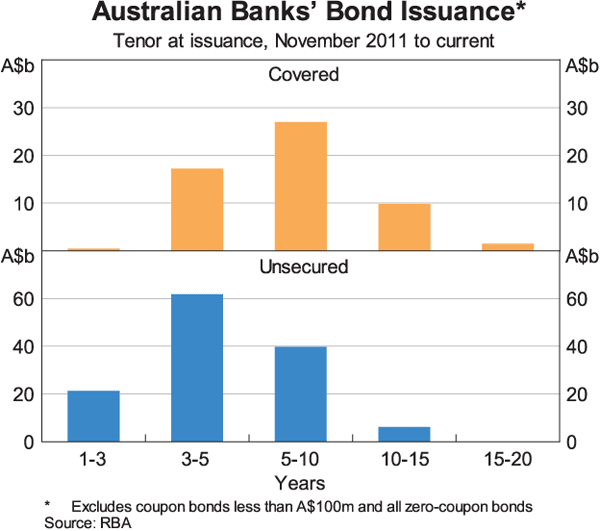
With the Australian banks supplying around 10 per cent of global covered bond issuance, compared with about 5 per cent of financials' unsecured issuance, they have established themselves as covered bond issuers in the global markets. The high share of global covered bond issuance reflects both subdued issuance by European institutions and the desire of the Australian banks to establish themselves in the market. Perhaps more importantly, these bonds have traded at similar spreads to comparable issues by foreign banks (Graph 3).
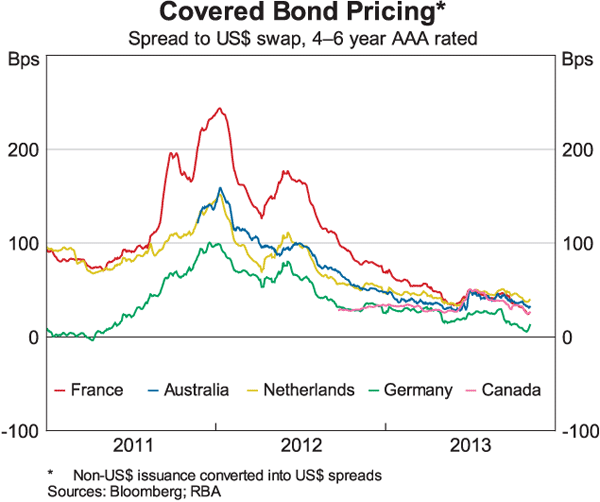
There is scope for further issuance, with each of the major banks having utilised roughly one-third of its limit (based on current levels of over-collateralisation). It is likely, however, that banks will use their remaining capacity sparingly, particularly if conditions in global funding markets improve further. Banks have indicated a preference to keep some capacity for covered issuance in reserve, to draw upon in the event of another bout of stress in global financial markets.
Developments in Securitisation
The improvement in funding market conditions since mid 2012 has also exerted its influence on the securitisation market. The past year has seen a steady run of deals, with pricing at some of the tightest spreads since 2007 (Graph 4).
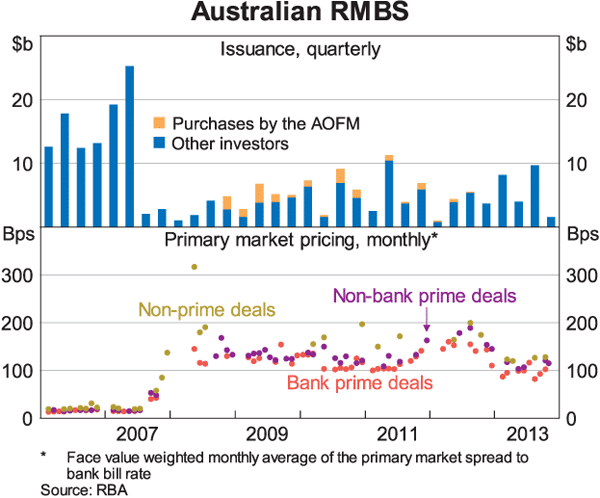
The decline in the cost of issuance has extended to non-bank lenders and smaller banks. In particular, a number of issuers have returned to the market after a hiatus of several years. And there has been a re-emergence of demand for non-prime RMBS, including deals with a significant number of loans with low documentation.
More broadly, investors seem to be increasingly comfortable with greater variation in pool characteristics. This is perhaps best illustrated by the greater variation in loan seasoning observed in the past couple of years (Table 1). Some issuers have been able to place loans with investors that they had previously held on their balance sheets for an extended period, while others have sold pools of relatively recent loans.
| 2009–2011 | 2012–2013 | |
|---|---|---|
| Minimum | 11 | 7 |
| Median | 33 | 40 |
| Maximum | 71 | 96 |
| Standard Deviation | 12 | 20 |
|
*Weighted average seasoning per deal Sources: RBA; S&P; Moodys; Fitch |
||
There has also been greater variation in the structures employed by issuers during the past several years. Some issuers have reduced their use of lenders' mortgage insurance (LMI), which follows a move by credit ratings agencies to discount the credit enhancement that LMI brings to an RMBS. On the other hand, credit support has been increased to maintain AAA ratings.
Recent years have seen the emergence of some preference for bullet structures to minimise prepayment and extension risk for investors. Offshore investors in particular have shown a preference for bullet features. This partly reflects the mandates of certain investors, such as US money market funds, to hold securities with finite maturities. Issuers have incorporated arrangements such as liquidity underwriting and rollover features to provide bullet-like structures to deals. Nonetheless, there are limits to the extent that these structures can be incorporated without significant over-collateralisation or liquidity underwriting costs. As such, bullet notes have typically accounted for a small portion of the funds raised in an RMBS. The securitisation market remains principally about passing through cash flows.
Taken together, the increased variation in deal characteristics, alongside tighter pricing and a solid pace of issuance, point to an improvement in the underlying demand for Australian RMBS. Indeed, with the recovery in demand from private investors, the Australian Office of Financial Management (AOFM) announced in April 2013 that it would not make any further investments in RMBS. For around 4½ years, the AOFM acted as a cornerstone investor, purchasing AAA rated tranches of smaller lenders' RMBS. In fact, the AOFM has actually sold a very small amount of RMBS in the past year. It currently holds more than $8 billion of these securities, compared with its peak of $11 billion in late 2011.
Some of the increase in private demand has come from abroad, which may reflect the dearth of marketed RMBS in some overseas markets. As you will be aware, RMBS issuance in Europe has been slow to recover amid subdued demand for credit among European households. Moreover, much of the securitisations that have occurred have been posted as collateral with central banks.
In Australia, the stock of mortgages is expanding at a slower pace than occurred during the adjustment to financial liberalisation and the low inflation environment (Graph 5). A related development is that housing turnover remains well below its peak in the early 2000s, which has contributed to a decline in prepayment rates. The corollary of this is that a lower level of RMBS issuance is required to fund a given share of Australian mortgages. In fact, the share of mortgages funded by securitisation has been more or less stable during the past year at around 8 per cent.
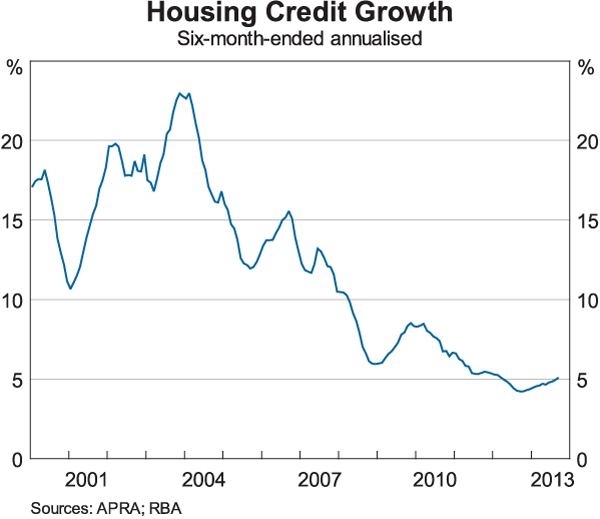
Alongside these slow-moving forces that are exerting themselves on the RMBS market, the global regulatory reform agenda is also playing its part. As the Reserve Bank has noted on more than one occasion, the ongoing effort to improve the regulation of the financial system, amid a reassessment of funding and liquidity risk by banks and investors, has the potential to affect the demand and supply of secured assets in a number of ways. The net result of these interactions is difficult to pin down.
To take one example, the Basel III liquidity standard might, all else equal, be expected to raise the demand for repo-eligible securities, including highly rated RMBS. However, it is difficult to disentangle the effects of this reform from the reassessment of liquidity needs by banks and investors. The approach taken by the Australian Prudential Regulation Authority and the Reserve Bank in the implementation of this reform has been carefully designed to have minimal disruption to the balance of supply and demand in securities markets. This extends to the classification of eligible securities for the Committed Liquidity Facility, as well as the various prices and haircuts that will be applied to eligible securities.
The Securitisations Project
I couldn't let this opportunity pass without saying something about the Bank's securitisations reporting initiative, which was announced at last year's conference. As has been stated previously, the Bank's primary motivation for collecting more information on asset-backed securities, such as residential mortgage-backed securities, is to better assess the risk of these assets as they have the potential to appear on the Bank's balance sheet.
In fact, around $20 billion of these securities will appear on the Bank's balance sheet later this month as banks' hold much higher cash balances with the RBA to cover settlement exchanges that occur after the close of the cash market each day. From 1 January 2015 on the order of $300 billion of these securities could potentially appear on the Bank's balance sheet with the introduction of the Bank's Committed Liquidity Facility.
Given this potential exposure, the Bank has a responsibility to ensure that the risk is well managed. The data the Bank receives will allow it to refine pricing where there are large geographic or borrower-type concentrations in loan pools, for example. And details of the cash flows associated with each security will provide greater transparency to the liability side of each transaction. This information will be particularly important for pricing self-securitisations, for which there are no market prices.
The Bank has also been motivated by an interest in promoting transparency in asset-backed markets. This recognises the inefficiencies associated with investors, other market participants and regulators not having access to relevant, reliable and standardised information in order to better understand and monitor risk. Regulatory reform will also result in increased demand for quality collateral.[3] To this end, the Bank has made it a requirement that certain information be made publicly available if securities are to be eligible for the Bank's open market operations.
In designing the templates, the Bank has been mindful of the need to balance concerns about privacy with investors' need to have enough information available to make a well-informed investment decision.
To address concerns about privacy, information providers will not report names and addresses and will replace actual loan and borrower identification numbers with dummy identifiers. In its latest round of consultation, the Bank has also proposed that loan-level data not be provided publicly at the postcode level. Property location will be identified in the loan template by an ABS statistically defined area, while a separate pool-level postcode summary of key variables in the loan template would be made publicly available. Certain dates will also be reported in calendar quarters, rather than exact dates; this will limit the ability to derive the property transaction date which will hinder borrower identification.
Users of the data will be limited to those with a legitimate purpose, such as potential investors and researchers. And these users will need to register with the information provider to access the data and enter into a binding agreement that limits the purpose for which the data may be used to an appropriate purpose. Under this agreement users should not be able to match, or attempt to match, the data against other information in order to identify an individual.
The final consultation period to determine the reporting templates is now closed. Once the Bank has considered the submissions and reported back to industry, which will occur this month, we will move into the implementation phase.
This is a large project for both issuers and the Bank. There are currently around 420 RBA eligible asset-backed securities and each issuer will have to bring together information from varied data sources. The deadline is also tight. Cognisant of this, the Bank has gone to tender for the external system which will support the new reporting requirements and, once this is finalised, will make available its technical requirements and give some sense of the relative importance of the various pieces of information, as early as is practicable.
Communications relating to this will be via the Bank's website – https://www.rba.gov.au/securitisations. This will be the official source of information and testing and implementation coordination for the new reporting requirements. For example, a worked hypothetical example of the cash flow waterfall, which will provide the industry with a concrete implementation of this reporting template, will be posted on this site shortly. I would strongly encourage people to visit the site and register for the RSS feed to receive alerts.
The Bank is also seeking progress reports from information providers every two months. Once again, I would strongly encourage information providers to complete these reports. These will give the Bank a good understanding of industry readiness and help us assist industry in its preparations.
Conclusions
In conclusion, the securitisation market continues to recover. And, two years on, it is clear that covered bonds are a useful funding tool for Australian banks, enabling them to diversify their investor base and extend the tenor of their issuance. These instruments will continue to provide Australian banks with access to a wholesale funding source that is less sensitive to global risk events than unsecured funding.
As for increased transparency in the securitisation market, I don't get the sense that the Bank is pushing against the tide. It's already happening in other jurisdictions and in my discussions with issuers and investors it is clear that they both see potential benefits. As a result I take some comfort in the fact that this is a collective endeavour!
Thank you for your time.
Endnotes
This speech was co-authored with Cameron Deans and Ashley Fang. [*]
For the Australian banking system as a whole, covered bonds have accounted for 27 per cent of long-term debt issuance. For the five banks that issue covered bonds – the four largest banks and Suncorp – the corresponding share is 34 per cent. [1]
See Debelle G (2011), ‘The Present and Possible Future of Secured Issuance’, Address to Australian Securitisation Forum, Sydney, 21 November. [2]
For a discussion of these issues see the Committee on the Global Financial System (2013), ‘Asset Encumbrance, Financial Reform and the Demand for Collateral Assets’, CGFS Papers No 49. [3]
